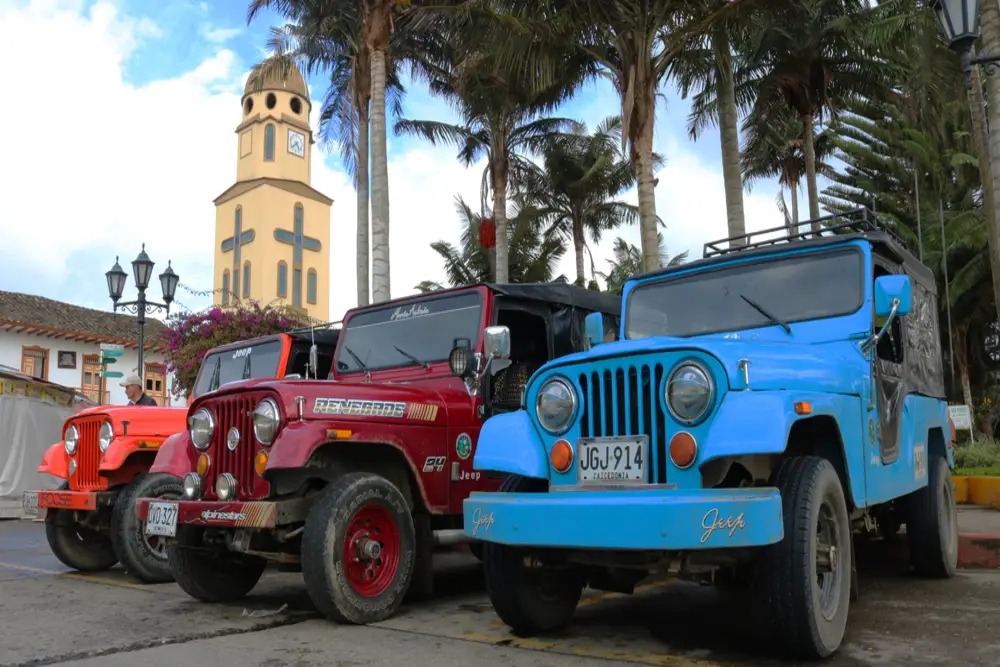Coffee cultivation in Colombia takes place in the Andes. The typical topography is mostly steep and the roads sometimes resemble mud tracks. The Willys jeeps are indispensable in this terrain today to transport the valuable coffee.
Table of Contents
The history of the Willys Jeep in Colombia
It’s strange, but coffee and wars have been linked in the history of many countries like France and Spain, and Colombia was no exception.
American soldiers of World War II needed versatile, fast vehicles that could easily traverse enemy terrain. So, the automobile manufacturers Bantam, Ford Motor Company and Willys Overland Motors joined forces and developed a vehicle that should fulfill these characteristics.
In 1946, the Ministry of War imported 300 vehicles and a few years later they were traded to the richest coffee producers in the Colombian coffee region for sacks of coffee.
The jeeps became very famous in the coffee region because they offered a solution to the problem of transporting large quantities of coffee.
To meet the needs of coffee farmers in search of these wonderful vehicles, the assembly company Leonidas Lara e Hijos imported the first version of these cars until 1961, when they became official Jeep assemblers in Colombia.
The Impact of the Jeep on the Colombian Economy
The Willys Jeep was more than a luxury, it was a necessity as most coffee farms are far from major cities and roads are generally in poor condition.
The roads are not only in bad condition, but also very narrow. So narrow that no truck can get into the most remote areas of the coffee-growing region. In the past, and in some cases still today, coffee was transported with pack donkeys.
A Colombian coffee brand named Juan Valdez paid homage to the hard work of coffee farmers and incorporated this into their logo. One finds there a mule and a muleteer as the main motive for the enterprise.
Thanks to the characteristics of Willys jeeps, the connection problems could be partially solved. Besides, it was also used for transporting people and many other crops because of its large loading capacity.
It is estimated that the economy in Colombia’s coffee region has grown exponentially since the Willys Jeep entered service, but by 1989 the drop-in coffee bean prices forced coffee farmers to migrate to the cities. However, this should not be the end of the Yipao, as the Willys Jeep was called in the coffee region of Colombia.
Due to the immense number of Yipaos in the coffee region, parades where coffee farmers had the opportunity to show their beautiful vehicle to tourists began.
In 1992, an importer came into the country with the latest Jeep models, and Jeep enthusiasts could update their old Jeep.
The Willys Jeep had its heyday when the roads were in terrible condition and it was the only vehicle that could move on bad roads. Today, the jeep isn’t quite as important to the economy as it was a few decades ago, but it’s still widely used.
The Willys Jeep has been declared a cultural heritage in Colombia
The Willys Jeep or Yipao is an excellent Colombian tourist attraction because of the way these vehicles are built, they are very easy to repair and because of this simple feature, the Colombian coffee farmers were able to completely rebuild these vehicles.
There are various parades or exhibitions of these vehicles. A culture has developed around these vehicles in Colombia, to such an extent that in 2020 the Congress of the Republic of Colombia enacted Law 2057 declaring the Willys Jeep the Intangible Cultural Heritage of the Nation.
This law was intended to promote the preservation and improvement of both these vehicles and the yipao traditions (traditions centered around the jeep or yipao).
Willys Jeep technical data
The Jeep CJ5 version has the following specifications:
Country of origin: United States
Manufacturer: Jeep
Model: CJ 5
Year of manufacture: 1954
Engine: 2199 cubic centimeters (cc) or 2.2 liters
Valves per cylinder: 2
Power: 60.00 horsepower (hp) at 3600 rpm
Torque: 145.00 Nm at 3600 rpm.
Fuel: petrol
Transmission: Manual with 3-speed gearbox.
Drive: 4WD
Weight of the jeep: 1030 kg.
Vehicle length: 3.52 meters.
Vehicle width: 1.55 meters.
Vehicle height: 1.74 m.
Type of front and rear brakes: drum brakes.
Load capacity: 274 kilos.
Fuel tank capacity: 57 liters.
Maximum speed: 105 km/h.



